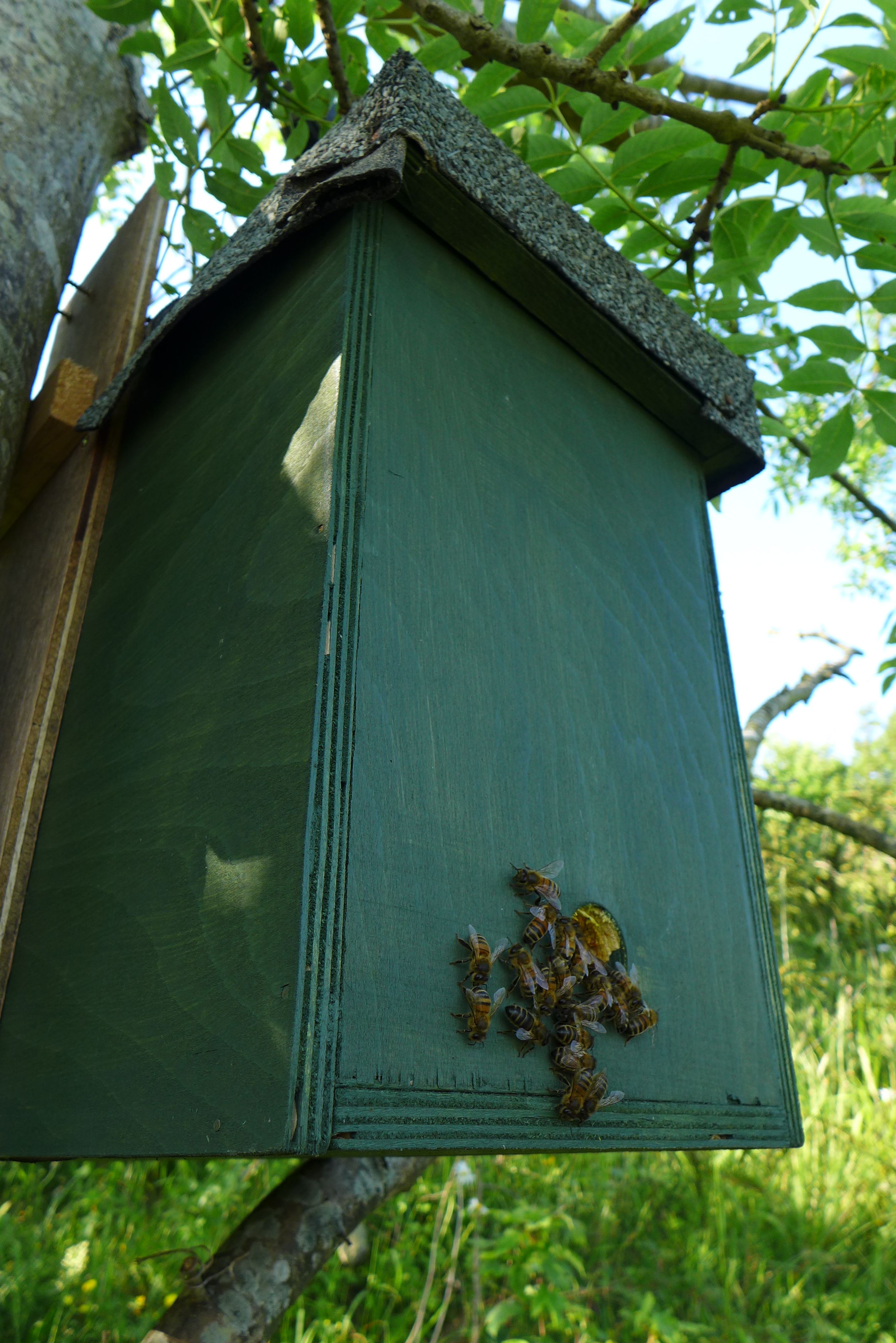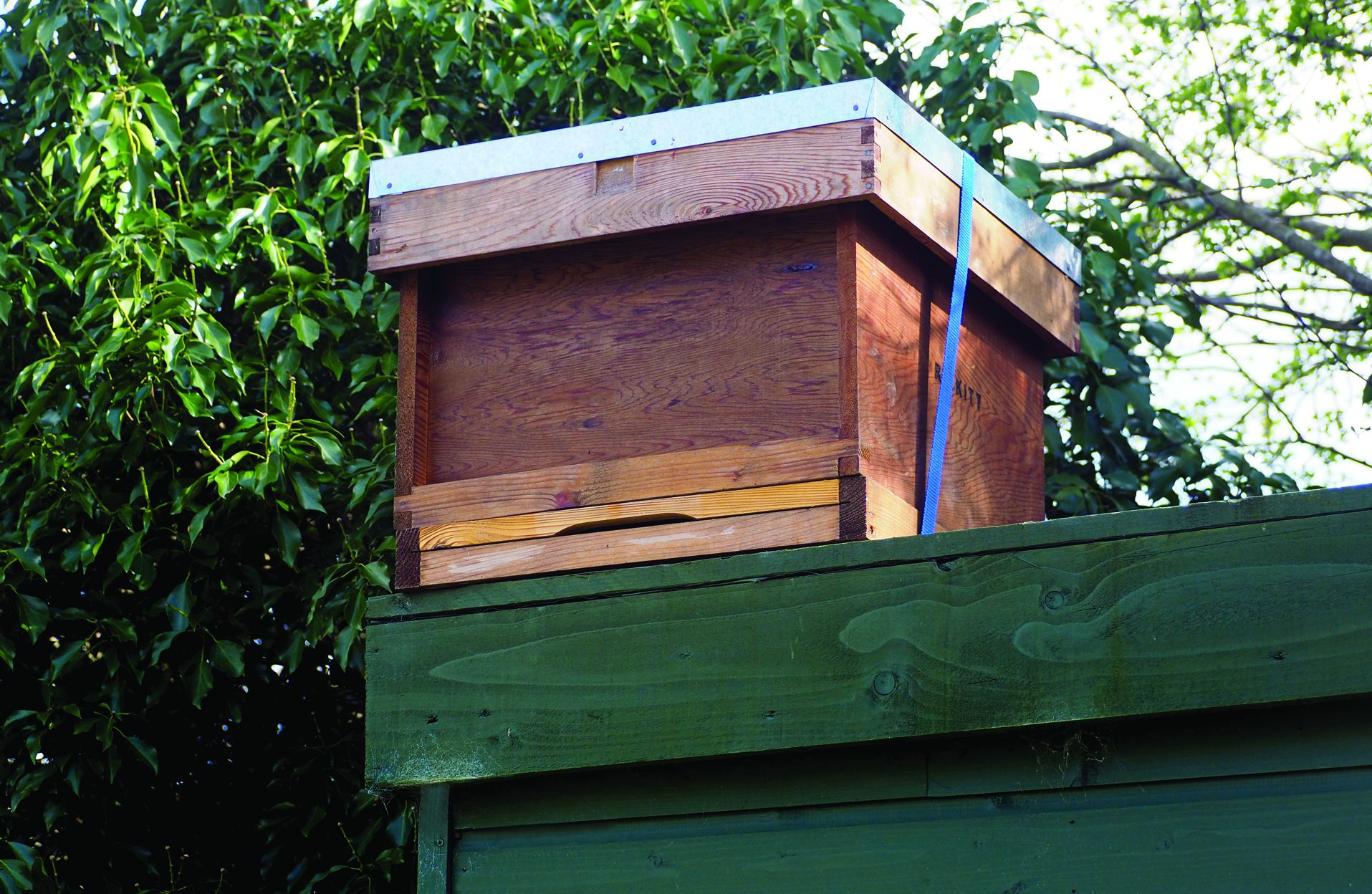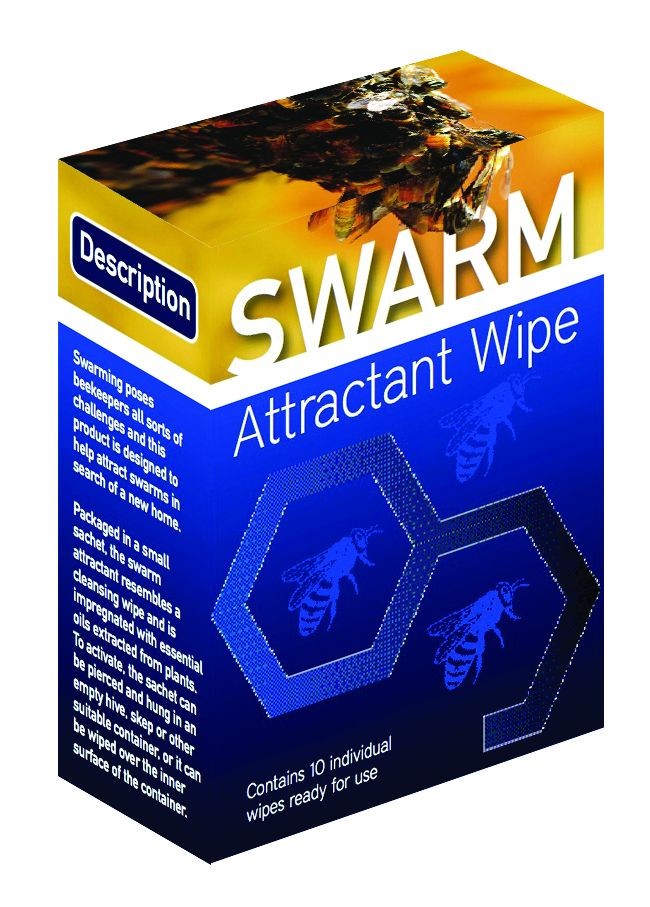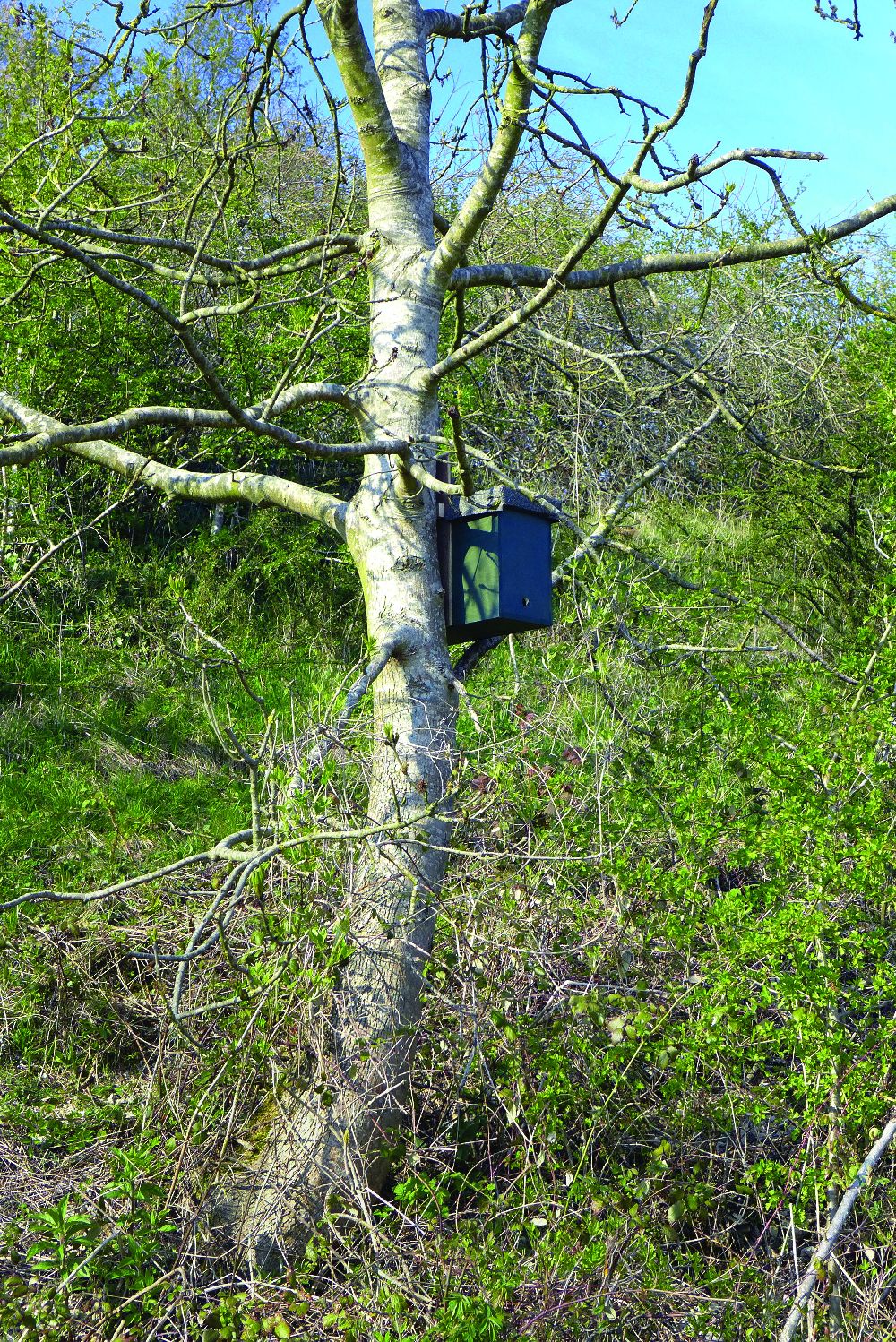Learning in the Apiary
 We all lose swarms now and then and it is sad to say goodbye to a favourite queen or a large workforce that might have gathered a good crop of honey. Furthermore, a swarm might become a nuisance to a neighbour if it moves into their chimney – and more of a nuisance to you when asked to remove them. Setting up bait hives between May and the end of July gives you a sporting chance of retrieving any swarms you might otherwise have lost and, perhaps more excitingly, gaining brand new bees from elsewhere. By Richard Rickitt, co-editor.
We all lose swarms now and then and it is sad to say goodbye to a favourite queen or a large workforce that might have gathered a good crop of honey. Furthermore, a swarm might become a nuisance to a neighbour if it moves into their chimney – and more of a nuisance to you when asked to remove them. Setting up bait hives between May and the end of July gives you a sporting chance of retrieving any swarms you might otherwise have lost and, perhaps more excitingly, gaining brand new bees from elsewhere. By Richard Rickitt, co-editor.
How to use bait hives
The need for bait hives
There is a certain thrill in finding that you have captured a swarm. It’s not just that you have acquired some bees for free, but also that you have provided a potential home that the bees have decided to use above all other available options. In his book Beekeeping – A Seasonal Guide, Ron Brown justifiably compares the anticipation of setting up bait hives to the excited expectation of planting lobster pots off a rocky coast.
Newly captured swarms seldom produce a honey crop in their first year. However, the rhyme ‘A swarm in May is worth a loadof hay’ is true in that a large prime swarm collected early in the season can indeed be profitable. In 2015, a prime swarm that moved into one of my bait hives in early May produced a surplus of almost 60lb (27kg) of honey by mid-August.
Although a honey crop is usually unlikely, a swarm’s impulse to draw new comb can always be exploited. By ensuring that it has plenty of food, and continually supplying it with frames of foundation, it will draw out frame after frame of good quality comb that can be used elsewhere.
New bees can also bring new genes. This can cause trouble, but some of my best bees have come from swarms of unknown origin. Another danger is the risk of disease. These potential problems can be mitigated by careful management.
Des res for honey bees
We have the work of Professor Thomas D Seeley to thank for establishing exactly what a swarm looks for in a new home. In his paper with Roger Morse, and subsequently in Seeley’s book Honeybee Democracy, there are descriptions of experiments offering swarms a range of options to see what exactly honey bees look for in a new home. Use the following as a guide to setting up a bait hive.
Size: About 40 litres
Interior: Dark, dry and draught proof
Entrance: small (about 15 cm2) at the bottom of the cavity
Location: south-facing, 5 metres from the ground, visible but in the shade.
What to use
 Fortunately (and hardly by chance), the volume that Seeley suggests is favoured by bees (about 40 litres) happens to be about that of a National deep brood box. A couple of supers stacked on top of each other will also do. I use National 14x12 brood boxes (See picture left) and these work well enough, as would those of any of the other commonly used hive types. Purpose-built bait hives are easy to make from scrap materials.
Fortunately (and hardly by chance), the volume that Seeley suggests is favoured by bees (about 40 litres) happens to be about that of a National deep brood box. A couple of supers stacked on top of each other will also do. I use National 14x12 brood boxes (See picture left) and these work well enough, as would those of any of the other commonly used hive types. Purpose-built bait hives are easy to make from scrap materials.
Bees are quite particular about having a sound, light-proof ceiling above their heads so you will need a good roof or lid. Bees are less likely to move into a draughty home, so a solid floor is better than open mesh. Make sure the entrance is small and easy to close – disc entrances are ideal. A spare five- or six-frame nucleus will work as a bait hive but will be passed over if something roomier can be found. Smaller swarms, possibly casts, might move into nucleus bait hives.
Bait
Old hive bodies will smell of wax, honey and propolis and will act as a lure to swarms. Even more tempting is a frame of old brood comb. Avoid combs containing honey which will attract robbers, or pollen which can attract wax moth. Only one comb is needed, any more and the cavity might be seen as too small by visiting scout bees. However, the box should be filled with empty frames, ideally with a small strip of foundation fitted at the top of each. Without frames a swarm of bees can fill a space with wild comb remarkably quickly – wondrous to look at but a pain to deal with.
 As well as old brood comb, you can try to attract scouts with other tempting smells. Lemongrass oil works well, just one or two drops dabbed inside the hive, and a few more around the entrance will help them find the potential nest site. Some commercially available swarm attractant wipes have a very good record of success, so, if you are very keen to collect swarms, these are worth trying.
As well as old brood comb, you can try to attract scouts with other tempting smells. Lemongrass oil works well, just one or two drops dabbed inside the hive, and a few more around the entrance will help them find the potential nest site. Some commercially available swarm attractant wipes have a very good record of success, so, if you are very keen to collect swarms, these are worth trying.
Location, location, location
Many people keep an empty hive or nucleus box in their apiary in the hope that their bees will move into it should they swarm. While this is possible, swarms moving into empty hives in your apiary are most likely to have come from elsewhere. The danger of placing bait hives in your apiary is that you could be inviting someone else’s diseased or undesirable bees to come and stay very close to your own.
 Evidence suggests that swarming bees tend to move some distance from home when looking for somewhere new to live. This makes evolutionary sense – if you want to spread your genes, or try to find new foraging opportiunities, it would be better to establish your new colony a considerable distance away from home.
Evidence suggests that swarming bees tend to move some distance from home when looking for somewhere new to live. This makes evolutionary sense – if you want to spread your genes, or try to find new foraging opportiunities, it would be better to establish your new colony a considerable distance away from home.
When preparing this article, we asked Tom Seeley how far from an apiary bait hives were best placed. He recommended a distance of at least 100 metres saying that he had had poor success with bait hives in trees adjacent to apiaries. He suspects that scout bees fly some distance from the home base before starting to look for cavities in order to ensure any new home is a healthy distance from the old one.
So, bait hives are probably best sited not in your apiary but some distance from it. This could mean placing boxes in neighbours’ gardens or in nearby parks, woods or churchyards (with permission). If you have out-apiaries, you could have a bait hive in your garden. It is fascinating to watch scout bees examining bait hives and thrilling to watch a swarm arrive and move in.
Try to place boxes so that they face south, are visible but well shaded.
Penthouse positions
 Tom Seeley found that bees prefer a nest site at least five metres off the ground. Although this might be the ideal height for bees, a height of about three metres is perhaps more practical. Importantly, the insurance provided to BBKA members covers you when retrieving swarms only up to a maximum working limit of three metres above the ground. I have had some luck with bait hives a couple of feet off the ground on ordinary hive stands but I believe they are more successful if higher up.
Tom Seeley found that bees prefer a nest site at least five metres off the ground. Although this might be the ideal height for bees, a height of about three metres is perhaps more practical. Importantly, the insurance provided to BBKA members covers you when retrieving swarms only up to a maximum working limit of three metres above the ground. I have had some luck with bait hives a couple of feet off the ground on ordinary hive stands but I believe they are more successful if higher up.
If you want to put a bait hive in a tree, build a small, stable platform in a position that is easy to reach and service. The hive should be strapped to the platform to keep it safely in place. The platform can be left in position and used year after year, but make sure you seek permission from the owner if it isn’t your tree. Other good positions are on flat-roofed sheds or garages.
Wherever you place a bait hive, remember that, should it be successful, lifting it down is going to be much harder than putting it up. It will be heavy with bees and full of fragile new comb. You will need to treat it gently and keep it fairly level – you might be wearing a beesuit, and you may well be on a ladder.
Check your boxes
At the height of the season, when looking after your established colonies can take up so much time, it is easy to overlook the regular checking of bait hives. Do try to inspect them once a week at the very least and certainly as soon as you think you have lost a swarm from one of your own colonies. Swarming bees will build and fill comb very quickly in their new home, making them more difficult to move the longer you leave them. Furthermore, there is a small window for the effective treatment of varroa (see below).
Beware disease
As when collecting swarms, there is a danger that the bees in a bait hive could be diseased. Any collected bees are very likely to be carrying varroa but the biggest worries are European foulbrood (EFB) and American foulbrood (AFB). The chances of the bees harbouring either of these are slight, but one of the two cases of AFB recorded in my county in the past five years came from a swarm of unknown origin, so the risk should be taken seriously. Bees that did not originate from one of your hives should therefore be quarantined at a temporary site at least three miles from your main apiary.
Once the queen starts laying, and certainly before there is any sealed brood (so, within colony with a trickled or vaporised, approved oxalic acid treatment. This will knock down the majority of the phoretic mites living on the bodies of the bees.
Allow newly caught bees to draw comb for at least three days using their own resources before you consider feeding them. The theory is that any disease spores or bacteria in the honey carried in the bees’ stomachs will be locked into the wax that they make. After three days a weak colony can be fed if necessary. Wait until there have been at least two complete brood cycles (about six weeks) with no signs of foulbrood before considering moving the bees to one of your apiaries.
I have a woodland site where all swarms of unknown origin are quarantined. I am in no hurry to introduce new bees to my apiaries and wait until towards the end of the season when I assess newly acquired colonies and decide if they are worth keeping. Smaller colonies might be united, other colonies might be requeened. Only when they are in a good state will they be moved back to one of my main apiaries for overwintering.
Moving your new bees
Bees coming and going from the entrance of your empty bait hive could be scout bees investigating the space inside. Bees entering with pollen are a sure sign that a swarm has settled in. If you do have a colony in your bait hive, be ready to remove it as soon as possible. The longer they are in residence, the harder they will be to remove. Always try to retrieve the bees during the current season. Late swarms have a low survival rate and any left untended in a bait hive are unlikely to survive the winter.
A newly arrived large colony will probably be a prime swarm with a mated queen. Within just a day or two of such a swarm arriving there is likely to be new comb with eggs. In this case, plan to move the bees straight away. If it is a small colony and you cannot see eggs, then it might be a cast swarm with a virgin queen. In such cases, I leave the colony alone for at least a week before checking again. This gives the young queen chance to leave the colony to mate. If you move a colony with a virgin queen you might disrupt her mating flights, and a moved colony without a mated queen is more likely to abscond.
When you move the colony, wear a beesuit and use some smoke around the hive. Close the hive entrance when you think most bees are inside (during cold weather or in the early morning or late evening), make sure the hive is well strapped together and very carefully lift it from its position. Make sure you have a plan, a well-secured ladder and some help. Take care that the bees do not overheat during transit.
Transferring bees
Once the bait hive is located in your apiary (or quarantine site), give the bees a few days to reorient themselves to the new location before transferring them to a new hive. If the bees have built comb in the frames provided, it is a simple matter of lifting them over to a new hive. If for any reason you find yourself with a box full of wild comb, you can cut the comb out and tie it into frames before transferring. Alternatively, a box of new comb and foundation can be placed over the top and the bees fed. Once comb is built in the frames in the top box, check that the queen is present on the top combs and place a queen excluder between the two boxes. After about three weeks, all of the brood in the bottom box will have emerged and the lower box and wild comb can be removed. Alternatively, you could try drumming the bees out of the bottom box and up into the one above (see Bee Craft, December 2018).
Ethics
Finally, who is to say that a captured swarm is actually your property? In law, bees are classed as ferae naturae (wild nature). This means a swarm that occupies your bait hive can no longer be said to belong to whoever lost it and you are legally entitled to hive and keep the bees. However, there is an accepted code of conduct among beekeepers that, if you have a reasonable suspicion of where the bees come from, it is polite to ask the owner if they would like them back. After all, next time it might be your favourite queen that has moved into your neighbour’s bait hive. It is not acceptable practice to place bait hives in the vicinity of an apiary belonging to a beekeeper whose bees you covet!
REFERENCES
Brown, Ron (1985). Beekeeping: A Seasonal Guide, Batsford.
Seeley, Thomas D, Morse, Roger A (1980). Bait Hives for Honey Bees, Cornell Cooperative Extension.
Seeley, Thomas D (2010). Honeybee Democracy, Princeton University Press.
Subscribe to BeeCraft Magazine
- £27.00* - Digital Subscription | 12 months
- £45.00* - UK Printed Subscription | 12 months
- £80.00 - UK Printed Subscription | 24 months
* UK residents over the age of 18 can subscribe to BeeCraft via Direct Debit and save up to £7.00 on your subscription. For more information on our Direct Debit scheme, please click here.
- £27.00 - Digital Subscription | 12 months
- £50.00 - Digital Subscription | 24 months
- £67.00 - RoI & European Printed Subscription | 12 months
- £27.00 - Digital Subscription | 12 months
- £50.00 - Digital Subscription | 24 months
- £90.00 - Worldwide Printed Subscription | 12 months


